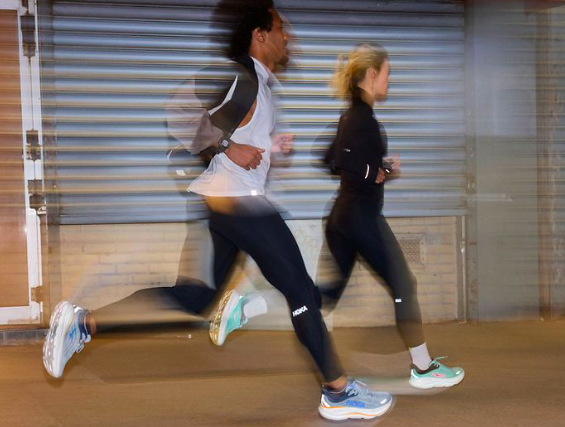Running Shoes 101

Key terms and features that will help you get started in selecting the right shoe for you!
If you’re new to running or just getting into this rapidly growing activity to get fit, explore cities and trails, meet new people or all of the above, walking into a store and staring at a wall of running shoes can be intimidating!
There are so many options and endless features. It’s hard to know where to start. So as you begin your quest to find the ideal running shoe for you, we thought we’d walk you through the four things that matter the most when selecting a running shoe.
These features are essential for choosing the right running shoe based on your running style, distance, and the surfaces you run on. Each element contributes to comfort, performance, and injury prevention.
Cushioning
What It Is: Cushioning refers to the padding within the midsole of the shoe, designed to absorb impact as your foot strikes the ground.
Why It Matters: Proper cushioning reduces the stress on your joints and muscles, especially during long runs. Different levels of cushioning suit various running styles, distances, and terrains. For example, maximalist shoes, like the Hoka Bondi 9, offer a lot of cushioning, ideal for long-distance runners who need more shock absorption, while minimalist shoes, like the ON Cloudflow 4, have less cushioning, promoting a more natural foot movement.
Heel-To-Toe Drop
What It Is: The heel-to-toe drop, or simply “drop”, is the difference in height between the heel and the forefoot of the shoe.
Why It Matters: The drop affects your running gait and how your foot strikes the ground. A higher drop (8-12mm) tends to promote heel striking, which can be beneficial for runners who need extra cushioning in the heel. A lower drop (0-6mm) encourages a midfoot or forefoot strike, which can help improve running efficiency and reduce certain injuries.
High Drop Shoes:
Asics Nimbus 27 (8mm drop)
Brooks Ghost 16 GTX (12mm drop)
Low Drop Shoes:
Altra Via Olympus 2 (zero drop)
HOKA Clifton 9 (5mm drop)
New Balance Fuelcell Supercomp Trainer v3 (6mm drop)
Outsole
What It Is: The outsole is the bottom part of the shoe that makes contact with the ground, usually made of rubber or other durable materials.
Why It Matters: The design and material of the outsole influence the shoe's grip, durability, and traction. For trail running, a more rugged outsole with deeper lugs, like the HOKA Speedgoat 6, is essential for better traction on uneven terrain, while road running shoes, like the HOKA Mach 6, typically have smoother outsoles for a lighter, more streamlined feel.
Upper
What It Is: The upper is the part of the shoe that wraps around the top of your foot, including the laces, tongue, and fabric.
Why It Matters: The upper's design and material impact the shoe's fit, support and breathability. Modern uppers often use engineered mesh or knit materials that provide a snug, sock-like fit while allowing for flexibility and ventilation. A well-designed upper can prevent blisters and provide the right amount of support without restricting movement.
When selecting the right running shoe for you, it’s important to speak to a knowledgeable, Certified FIT specialist. At The Right Shoe we’ll provide you with one-on-one attention, ask you the right questions, and offer you guidance and support in finding your ideal fit and feel. Book an appointment or come in to experience our exceptional service and memorable support. We’re excited to help you get started and experience the joy of running!
Interested in joining us for one of The Right Shoe's monthly Run Series events? Click here for details and registration.
Would you like to learn more about running shoes including new releases and the latest features? Follow us on Instagram @therightshoevan and tune into Barry's Best!